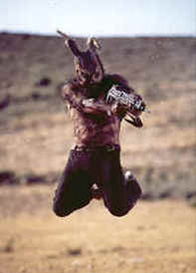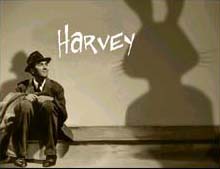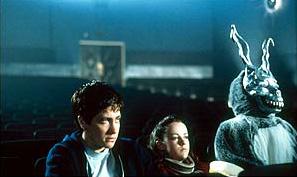So what’s with all the evil bunny suits?
The phenomenon can no longer stay unnoticed: What is it with the recent prevalence of sinister-looking bunny suits in indie films? I see evil man-rodents everywhere! Don’t you?


Spot the difference: Donnie Darko & Starfish Hotel
The movie that unofficially kicked off this subliminal trend may have been Gummo (1997), which featured a creepy kid with large bunny ears. Three years later, audiences were haunted by Gal Dove’s long-eared ghost from the past in Jonathan Glazer’s Sexy Beast (2000). Next up was spirit animal Frank in the cult-favorite Donnie Darko (2001), and then “The Mysterious Bunny Man” in Cabin Fever (2002) reared its ugly head. Meanwhile, David Lynch – never one to waste a good surreal image – treated the visitors of his website to a stage with a family in rabbit costumes in his curious sitcom Rabbits (2002). Much to the confusion of Geoffrey Macnab, Lynch appears to have incorporated similar sequences in his latest feature film Inland Empire (2006), offering no explanation whatsoever. And if the aforementioned titles convinced you that we’re dealing with a typical Anglo-Saxon phenomenon, the recent release of the Japanese supernatural detective thriller Starfish Hotel (2006) and this South-Korean poster for Chan-Wook Park’s upcoming film I’m A Cyborg will no doubt change your mind.


Left: Gummo, right: Sexy Beast
But that’s not all. Something similar seems to be going on in the realm of music videos. Just watch Pink’s Just Like A Pill, Christina Aguilera’s Dirrty, or Do You Realize by The Flaming Lips. Distressingly enough, the evil-bunny-suit fever is currently spreading out over the Internet, infecting esoteric cinephiles in the blogosphere (source: Greencine Daily‘s David Hudson).
How are we to take this odd phenomenon? Is it a metoo effect? Plain old ripping off? In an interview held by fellow-blogger Ross Ruediger at The Rued Morgue, Firecracker director Steve Balderson discourages the plagiarism accusation:
Say I’m inspired by a surrealist piece of art where there’s a man wearing a giant stuffed-animal costume. Let’s say I wanted to incorporate that idea into my movie. Well, some might say I stole the idea from Donnie Darko, which features a person dressed in a stuffed-animal costume. Or, others might suggest I’m trying to be David Lynch because he did the same thing with Naomi Watts dressed in a bunny outfit.
By focusing on things like that, people will fail to recognize what it is that I’ve done. Never mind I’ve never seen the David Lynch scene with Naomi Watts. Never mind that my inspiration had nothing to do with Donnie Darko. What I think would be more interesting is if one would ask the question: What drives an artist to arrive at a similar conclusion? Where did the choice originate to put someone in a stuffed-animal costume? By answering that question, and appreciating what is on screen all in and of itself, the viewer will get more out of it.
Amen to that. So, leaving aside Balderson’s fictional example of that “surrealist piece of art,” what is the real origin of cinema’s ongoing fascination for people in stuffed-animal costumes? Are we facing the painful aftereffects of a generation of filmmakers traumatized over Monty Python and the Holy Grail? Probably not… Although some people have pointed out eerie similarities between Donnie Darko and the film Harvey (1950), in which James Stewart as Elwood P. Dowd has an imaginary six foot rabbit friend, much like Donnie has Frank. Writer-director Richard Kelly, however, claims he has never seen the Jimmy Stewart film (nevermind the Bruce Willis remake) and that his Frank was inspired by the novel Watership Down.

Harvey: Early blueprint for
the current man-rodent craze?
Eli Roth – who insists that his screenplay for Cabin Fever was written in 1995, long before Donnie Darko came out – names a completely different source of inspiration in an interview with Rebecca Murray:
ROTH: The Bunny Man was very influenced by The Shining. There’s a scene in The Shining where Shelley Duvall’s running around the hotel and she sees these creepy things. There’s a guy in a bear suit who is just really, really, really weird. It always stuck with me as a kid so it’s kind of my little nod to The Shining.
MURRAY: But that was a bear, and this is a bunny. Why the change to a bunny?
ROTH: We just couldn’t find a bear suit. I think that there’s something very evil about a bunny suit.

Cabin Fever
The quote above tells me that, as far as this little investigation is concerned, a focus on direct influences will lead us nowhere. Maybe we should be digging deeper. Perhaps there is something about the image of a person in a rabbit outfit that resonates for these filmmakers on a level even they cannot quite fathom. As unlikely as it may seem, maybe we just need to accept the possibility that evil man-rodents are… in the air.
What’s that, am I being too vague? Well, prepare for a dip into Donnie Darko territory as I indulge myself in a little game of pseudo-scientific free-association.

David Lynch’s Rabbits
With his innovating theory of morphic resonance, the controversial British biologist Rupert Sheldrake proposes that self-organizing systems of all levels of complexity – atoms, molecules, crystals, organelles, cells, tissues, organs, organisms, societies, ecosystems, planetary systems, solar systems, galaxies – are shaped by morphic fields that contain an inherent memory. In the human realm, Jung referred to this as the collective unconscious. The process of morphic resonance takes place when phenomena – particularly biological ones – become more probable the more often they occur, so that growth and behaviour are guided into patterns laid down by previous similar organisms. In other words: much of what we are, think and do is inherited without us realizing it. A constantly updated pool of collective memory binds us even when we’re oceans apart. Seen from this angle, even mental activity and perception can be viewed as habits, and habits are subject to natural selection.
It begs the question: Can a successful creative idea cause a certain thinking pattern to spread and evolve into a habit? When one filmmaker has contemplated the use of a bunny suit for sinister effect, does it become easier for others to arrive at the same cinematic solution by simply tuning into the same wavelength? Call it “creative instinct,” “tapping into the Zeitgeist,” or “divine inspiration,” if you like. Wouldn’t such a theory (Gelderblom’s Hypothesis of Collective Inspiration–bring on the Nobel Prize, baby!) explain the contemporary wave of CGI-animated movies featuring domesticated furry animals heading back to the wild?

Or am I simply behaving like the pattern-seeking animal that I am (to borrow Jim Emerson‘s favorite phrase) and is our unhealthy obsession with evil bunny suits, of all things, God’s idea of a practical joke on humanity? I’ll leave the final words to Richard Kelly’s Donnie and Frank:
DONNIE: Why do you wear that stupid bunny suit?
FRANK: Why are you wearing that stupid man suit?


hehehe, the bunny virus has spread to the Orient, as can be seen on the poster for Chan-Wook Park’s new film:
http://www.twitchfilm.net/pics/cyborgposter.jpg
Thanks, Max404. I rest my case…
I have added a mention of Chan-Wook Park’s new film in the article to enhance my argument. Keep those sightings coming, people! Let’s make this post the Ultimate Evil Bunny Suit Reference.
Pingback: More rabbits! at Dreamland Industries
Another rabbit suit sighting!
In his report of the Fantasia 2006 festival, Randolph Jordan mentions a film called EXECUTIVE KOALA, in which a business man in a Koala suit has a boss with a stuffed-rabbit head! (The rest of the cast is plain human.)
Check it out:
http://www.offscreen.com/biblio/phile/essays/fantasia_20061/
The Flaming Lips’ bunny suit is on the side of good, not evil. It ascends to heaven at the end, as I recall?
You know there are semi-evil giant bunnies in The Sims? They appear when a character goes insane.
Harvey, Holy Grail, and Watership Down are excellent predecessors–I doubt the connection is accidental, since they all balance precariously between comedy and tragedy, child and adult, entertainment and cruelty. That’s seems like a fitting origin for evil bunny plague. Of course, the simplest explanation is Velvet Clown Painting Syndrome. Why are clowns scary and sad? Because they’re not supposed to be.
I wonder if the image of the playboy bunny is, in some convoluted, twisted way, connected to the phenomenon? And if so, how? That is, after all, the only way anyone really sees human sized bunnies.
Such a sound theory: Bunnies are evil because they’re not supposed to be. Thanks for sharing that wisdom with us, Yan! I didn’t know that about The Sims. Not even the gaming world is safe anymore…
Playboy bunnies? Now THAT’s opening a can of Freudian worms. The thought had crossed my mind, but I don’t group anything that gives me a hard-on under evil. Call me naive, I don’t care.
Just check youtube using the term evil easter bunny….i WANT that suit! ^^
hey
dat bunny in da shinning propa freaks me out i cant stop thinking about how sycological it was btw i tnk it was a rabbit not a bear but it woz freaky n wat was it doing wid dat man?
While zapping, I spotted an evil man in a bunny suit in an episode of CGI. Possibly a murderer, too. It’s impossible to keep track!
I know the evil santa bunny is photoshopped, but does anyone know where the origional picture of what that… thing is? i’ve been looking all over for it.
http://wickedstageact2.typepad.com/life_on_the_wicked_stage_/WindowsLiveWriter/CheneyOReillyandOtherBadActors_F52F/evil_easter_bunny4.jpg
you can get a Frank the Bunny costume at http://www.kreationx.com
thanks
mike
In the television series Buffy the Vampire Slayer, the character of Anya is terrified of bunnies, but then dresses in a bunny suit in one of the Halloween episodes.
just found this image of three ‘evil’ bunnys with two young children, apparently from the 60’s. check it outhttp://cgi.ebay.co.uk/60s-POLAROID-EVIL-EASTER-BUNNY-CAPTURES-GIRLS-WEIRD_W0QQitemZ380010725848QQihZ025QQcategoryZ48QQrdZ1QQssPageNameZWD2VQQcmdZViewItem?_trksid=p1638.m122
I always found the Donny Darko bunny to be so creepy. I loved that movie though.
There is also a scene in The Twilight Zone Movie where a terrifying claymation bunny jumps out of a present. Great post, love the mythology!
For all of you evil bunny lovers…
http://www.youtube.com/watch?v=ru1Ta2v8M7g
Pingback: Slow Week for Posting . . . « Very Important Stuff
Hi, first I want to say great blog. I don’t always agree with your blogposts but it’s always a interesting read.
Keep up the good work.
I recall watching a movie as a kid with a gunfight of which a man shows up in a bunny suit. I am trying to find the name of the movie, but all I remember is that said man in bunny suit takes the time to sit with a bullet riddled man, consoling him.
If anyone remembers the name of the movie, it would be appreciated.
Great post, I’d just noticed this and it was cool to see a write-up, even if it is all just confirmation bias.
One little nitpick, though, it’s “raises the question”, not “begs the question”, begging the question is asking a question that presupposes certain facts, like “when did you stop beating your wife?”
It is my great pleasure to visit your website and to enjoy your excellent post here. I like that very much. That is very kind of you to do this for us. Thank you very much. If you are looking for mac cosmetics , here is the right place. We are engage in mac comestic
Trackback: bubble shooter
Don’t forget “Santa Sangre,” where he hides the dead body in the giant bunny costume